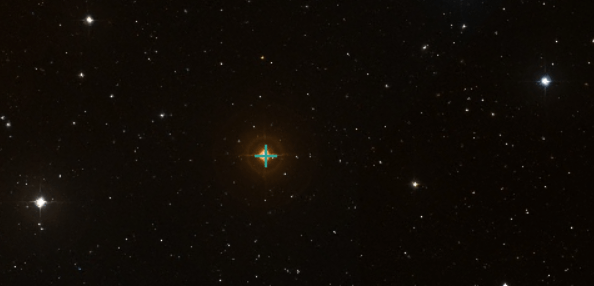Star of the Month
X Cancri
AKA: HR 3541; HD 76221
Position: 08 hrs 55 min 22.9 sec +17 degrees 13 min 53 sec
Due south at 23:13 (GMT) on 15 February 2022
X Cancri
Image: Simbad (http://simbad.u-strasbg.fr/simbad/)
The Victorian astronomers were fascinated by red stars, for example Herschel’s garnet star (Mu Cephei; Star of the Month for September 2020) and Hind’s red star (R Leporis; Star of the Month for January 2020). There were famous catalogues of red stars, the first major one was by the Danish astronomer Hans Schjellerup (1827-1887). This was extended and improved by the Irish astronomer John Birmingham (1816-1884), which was in turn revised by the Revd T.H.E.C. Espin (1858-1934). Espin also took over Celestial Objects for Common Telescopes from the Revd. T.W. Webb. The most red stars are, in fact, carbon stars; red giants with large amounts of carbon (basically soot) in their atmospheres. These carbon stars are characterised by Swan bands in the visible spectrum which are also seen in hydrocarbon flames. They were discovered in 1857 by the Scottish physicist William Swan (1819-1894) in 1857 and are produced by the C2 radical-molecule. In the same year, Swan was also the first person to realise that Fraunhofer’s D line in the solar spectrum was produced by sodium.
So much for history; what about X Cancri? It has a B-V colour index of 3.0 which means it is very red, but there are stars which are even redder such as V Hydrae (Star of the Month for April 2020) which has a B-V value of 5.4, but X Cancri is one of the brightest carbon stars. It is an aging red giant which has entered the asymptotic giant branch of the Hertzsprung-Russell diagram and has been burning helium to form carbon. It is now essentially entering its death throes and is behaving erratically. Hence it is a pulsating variable. The variation is not that much, between 5.5 and 7.5, which means in theory that at its peak brightness it is visible to the naked eye; though not in Havering. The semi-regular period is 193 days and it has two pulsation periods, of 350 and 1870 days. It is currently near its minimum, being reported by the AAVSO as being magnitude 7.1 on 3 February. It has been generally dim over the last year with occasional flare-ups.
To find X Cancri, locate the fairly bright star Delta Cancri aka Asellus Australis (the southern donkey colt, M44 being its “manger”) just below M44 which is magnitude 3.9. Then look in your binoculars or finderscope to the lower left on a line between Delta Cancri and Regulus in Leo. You will see three stars of roughly similar brightness in a line, namely HD 76508 on the left which is mag. 6.1 and HD 75864, mag. 6.9, on the right, with X Cancri which should hopefully be obviously red, in the middle. The other two stars will help you to determine the current magnitude of X Cancri; it can be dimmer than the one on the right (the left one if you are using a diagonal) and brighter than the one on the left.

HD 76508 on the left, X Cancri Iin the middle and HD 75864 on the right
In this image X Cancri looks slightly brighter than HD 76508
Image: Simbad (http://simbad.u-strasbg.fr/simbad/)
